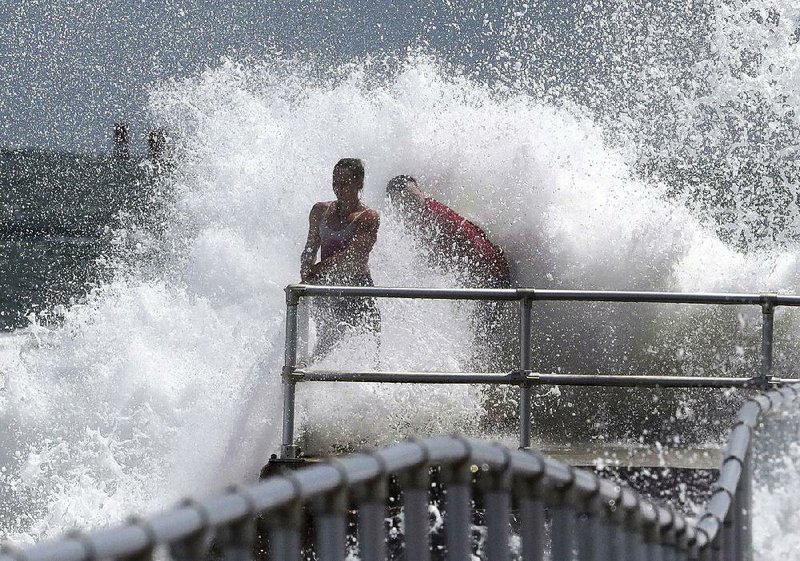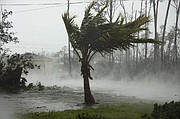NASSAU, Bahamas -- Hurricane Dorian caused flooding across the Bahamas on Monday, leaving at least five people dead, while Florida residents waited for the storm to take a northern turn that would spare their state.
Authorities in the Bahamas urged people to find flotation devices and grab hammers to break out of their attics if necessary.
"We are in the midst of a historic tragedy," Prime Minister Hubert Minnis said in announcing the fatalities. He called the devastation "unprecedented and extensive."
Dorian hit the Bahamas with the highest possible intensity, as a Category 5 storm, weakening to a Category 4 with winds of 145 mph as it inched offshore. In 24 hours, it traveled only 70 miles -- roughly 3 mph. It shredded roofs, hurled cars and forced even rescue crews to take shelter until the onslaught passed.
On Monday, it was centered about 25 miles northeast of the city of Freeport as hurricane-force winds extended outward as far as 45 miles from the center. Tropical storm-force winds stretched 150 miles each way.
"The Bahamas is presently at war and being attacked by Hurricane Dorian," Minnis said in an interview. "And yet, [the Bahamas] has no weapon at its disposal to defend itself during such an assault by this enemy."
[Video not showing up above? Click here to watch » https://www.youtube.com/watch?v=tZJF5b6FSg4]
The U.S. Coast Guard was deploying helicopters to evacuate the injured from the Marsh Harbour clinic on devastated Great Abaco island, flying them back to the Bahamian capital, Nassau, for urgent care. Other rescue efforts were largely suspended until Wednesday, when conditions are expected to improve.
In the storm's direct wake were flooded neighborhoods, debris fields and broad destruction. Minnis said the five confirmed deaths happened on the Abaco Islands. The airport in Freeport -- the nation's second-largest city, with a population about 27,000 -- turned into a river of rushing tidewaters.
Tidal surges from the storm were projected to reach up to 23 feet above normal levels, overwhelming low-lying cays and islands.
Severe flooding and power and phone failures extended beyond the worst of the strike zone, as far south as Nassau.
A spokesman for Bahamas Power and Light told the radio station ZNS that there was a blackout in New Providence, the archipelago's most populous island. He said the company's office in the Abaco Islands was flattened.
"The reports out of Abaco, as everyone knows," spokesman Quincy Parker said, pausing for a deep sigh, "were not good."
FACING THE STORM
With phone, Internet and power lines down in many places, communication with the islands was difficult, but some managed to get through.
On Twitter, Freeport resident LaToy Williams posted video of water more than 6 feet deep submerging his front porch and lapping at his windows.
"God be with us, God be with us, God be with us," he says. "Y'all keep praying out there, worldwide."
"Right now, we are getting lashed with strong winds and heavy rains," said Lisa Pakosh, a Freeport resident. "Cell service is sporadic, but I have been in contact with friends over the bridge whose home flooded, and they are stuck with their young daughter on their countertops. Other friends have retreated to their second floor, as water has filled their main floor."
Jamie Rose, 44, a Grand Bahama resident, said he had been in contact with his parents, who live in a lower-lying part of the island.
"They're trying to keep themselves alive," Rose said. "Their house is built about 12 feet above high tide, and the water is now about 2 feet above the level of their windows in the living room. It's hurricane glass, but they're basically sitting in a fish tank looking out at the water hitting the windows."
The Bahamas' agriculture and marine resources minister, Michael Pintard, posted a video online of the storm surge hitting his windows.
"That's my kitchen window that water is hitting," Pintard says. "That has to be a minimum of about 20 feet off the ground."
Deputy Prime Minister Peter Turnquest, riding out the hurricane on Grand Bahama, said authorities were worried by the severity of the storm.
"We are extremely concerned, especially for the residents of the eastern end of the island and the cays, which are low-lying," he said.
Michael Scott, chairman of the government-owned Grand Lucayan Resort and Casino on Grand Bahama, called the storm "apocalyptic" and "a truly cataclysmic event."
His beachfront hotel, he reported, was operating as a refuge because many of the structures that were originally designated as shelters in Freeport, the island's main city, were damaged.
In Freeport, Gail Woon, 60, an environmentalist, sat in one of the functioning shelters. Flashbacks from previous hurricanes, she said, were haunting her.
"This is terrible," Woon said. "These climate-change hurricanes are terrible."
This is the first time since at least the start of the satellite era in the 1960s that Category 5 storms have developed in the tropical Atlantic for four consecutive years, according to Capital Weather Gang tropical weather expert Brian McNoldy.
IN THE U.S.
Along the U.S. East Coast, meanwhile, residents either hunkered down or got out.
The National Hurricane Center on Monday extended watches and warnings across the Florida and Georgia coasts. Forecasters predict Dorian will make its northern turn in the next day or so near Palm Beach County and weaken as it travels up the coast, but meteorologist Daniel Brown cautioned that "only a small deviation" could draw the storm's dangerous core toward land.
In an advisory, the center cautioned that "Dorian's wind field is predicted to expand, which would bring hurricane-force winds closer to the east coast of Florida even if the track does change."
On Labor Day, much of Florida's coast remained under a hurricane or tropical storm watch. But as of 5 p.m. Eastern Daylight Time, all of south Florida was out of the cone of uncertainty -- the possible path for the storm.
[Video not showing up above? Click here to watch » https://www.youtube.com/watch?v=6ILqCnDvz2s]
Authorities in Florida ordered mandatory evacuations in some vulnerable coastal areas. Tolls were suspended on South Florida roads. Palm Beach International Airport closed Monday, and flights were suspended at Fort Lauderdale-Hollywood International Airport at noon. Deputies in Martin County closed two major causeways leading to area beaches.
Gusts of tropical storm-force winds were starting to reach the area. One gust of 47 mph was reported at the Juno Beach Pier, according to the National Weather Service.
"It's going north," said Ann Huff, a 30-year Juno Beach resident who huddled under a sea grape tree near the beach with her husband. "When I was pregnant, I knew I was going to have a boy. I have the same feeling here. It's going north."
But authorities were preparing in case the storm turns west. Residents of 72 nursing homes or assisted-living facilities along Florida's coast have been evacuated, and some hospitals from New Smyrna Beach to Port St. Lucie have begun evacuating patients.
Gov. Ron DeSantis, at a morning news conference, implored health care facility administrators to update the state on how their generators are working and on their evacuation status.
"If you have a generator, and something's wrong with the generator, you need to tell us that," he said.
Serious storm effects are likely in coastal Georgia and the Carolinas in the middle and latter half of the week as Dorian picks up speed and heads north, but the risks are also heavily dependent on the storm track.
A hurricane landfall in the Carolinas, especially North Carolina, is a distinct possibility by late Thursday.
A mandatory evacuation of the entire South Carolina coast took effect Monday, covering about 830,000 people. Transportation officials reversed all lanes of Interstate 26 from Charleston to head inland earlier than planned after noticing traffic jams from evacuees and vacationers heading home on Labor Day, Gov. Henry McMaster said.
Georgia's governor, Brian Kemp, ordered mandatory evacuations for that state's Atlantic coast, also starting at midday Monday.
North Carolina Gov. Roy Cooper warned his state that it could see heavy rain, winds and flooding later this week.
A National Guard official, John Anderson, said many people along the coast were complying with the evacuation orders.
"We have not seen much resistance at all," he said in a phone call with reporters. "People do understand that Dorian is nothing to mess around with."
Information for this article was contributed by Michael Weissenstein, Danica Coto, Ramon Espinosa, Tim Aylen and Seth Borenstein of The Associated Press; by Jasper Ward, Anthony Faiola, Jason Samenow and Andrew Freedman of The Washington Post; by Alex Harris, Joey Flechas, Sarah Blaskey and David Ovalle of the Miami Herald; and by Kirk Semple, Elisabeth Malkin and Frances Robles of The New York Times.
A Section on 09/03/2019

